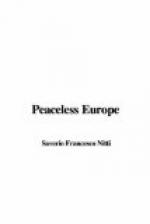Eighthly, the moral unrest deriving from these conditions has divided among themselves the various Entente Powers: United States of America, Great Britain, Italy and France, not only in their aims and policy, but in their sentiments. The United States is anxious to get rid, as far as possible, of European complications and responsibilities; France follows methods with which Great Britain and Italy are not wholly in sympathy, and it cannot be said that the three Great Powers of Western Europe are in perfect harmony. There is still a great deal of talk about common ends and ideals, and the necessity of applying the treaties in perfect accord and harmony, but everybody is convinced that to enforce the treaties, without attenuating or modifying their terms, would mean the ruin of Europe and the collapse of the victors after that of the vanquished.
Ninthly, a keen contest of nationalisms, land-grabbing and cornering of raw materials renders friendly relations between the thirty States of Europe extremely difficult. The most characteristic examples of nationalist violence have arisen out of the War, as in the case of Poland and other newborn States, which pursue vain dreams of empire while on the verge of dissolution through sheer lack of vital strength and energy, and becoming every day more deeply engulfed in misery and ruin.
Finally, Continental Europe is on the eve of a series of fresh and more violent wars among peoples, threatening to submerge civilization unless some means be found to replace the present treaties, which are based on the principle that it is necessary to continue the War, by a system of friendly agreements whereby winners and losers are placed on a footing of liberty and equality, and which, while laying on the vanquished a weight they are able to bear, will liberate Europe from the present spectacle of a continent divided into two camps, where one is armed to the teeth and threatening, while the other, unarmed and inoffensive, is forced to labour in slavish conditions under the menace of a servitude even more severe.
II
THE PEACE TREATIES AND THE CONTINUATION OF THE WAR
The various peace treaties regulating the present territorial situation bear the names of the localities near Paris in which they were signed: Versailles, Saint-Germain-en-Laye, Trianon and Sevres. The first deals with Germany, the second with Austria, the third with Hungary, and the fourth with Turkey. The Treaty of Neuilly, comparatively far less important, concerns Bulgaria alone. But the one fundamental and decisive treaty is the Treaty of Versailles, inasmuch as it not only establishes as a recognized fact the partition of Europe, but lays down the rules according to which all future treaties are to be concluded.
History has not on record a more colossal diplomatic feat than this treaty, by which Europe has been neatly divided into two sections: victors and vanquished; the former being authorized to exercise on the latter complete control until the fulfilment of terms which, even at an optimistic point valuation, would require at least thirty years to materialize.




